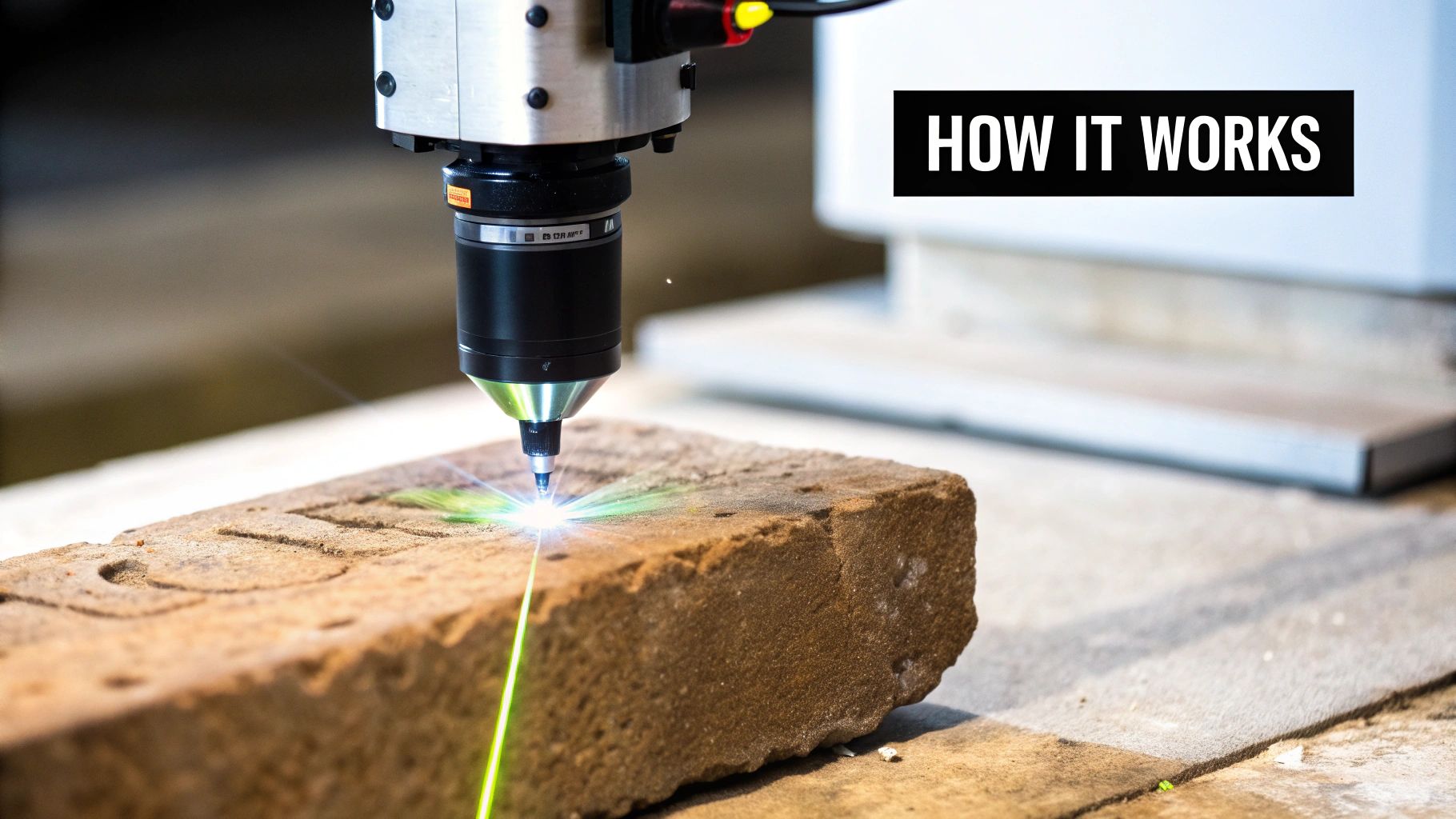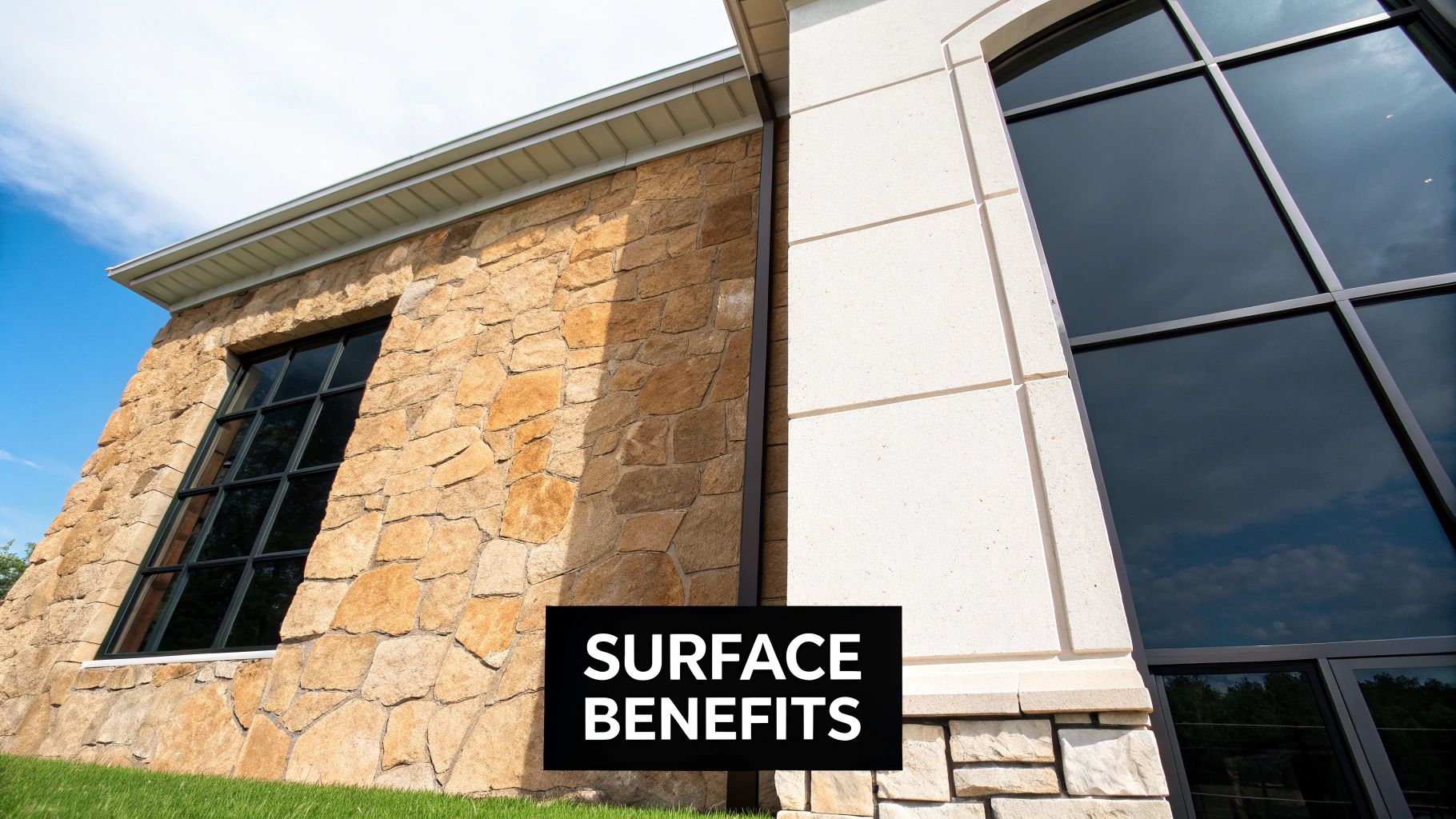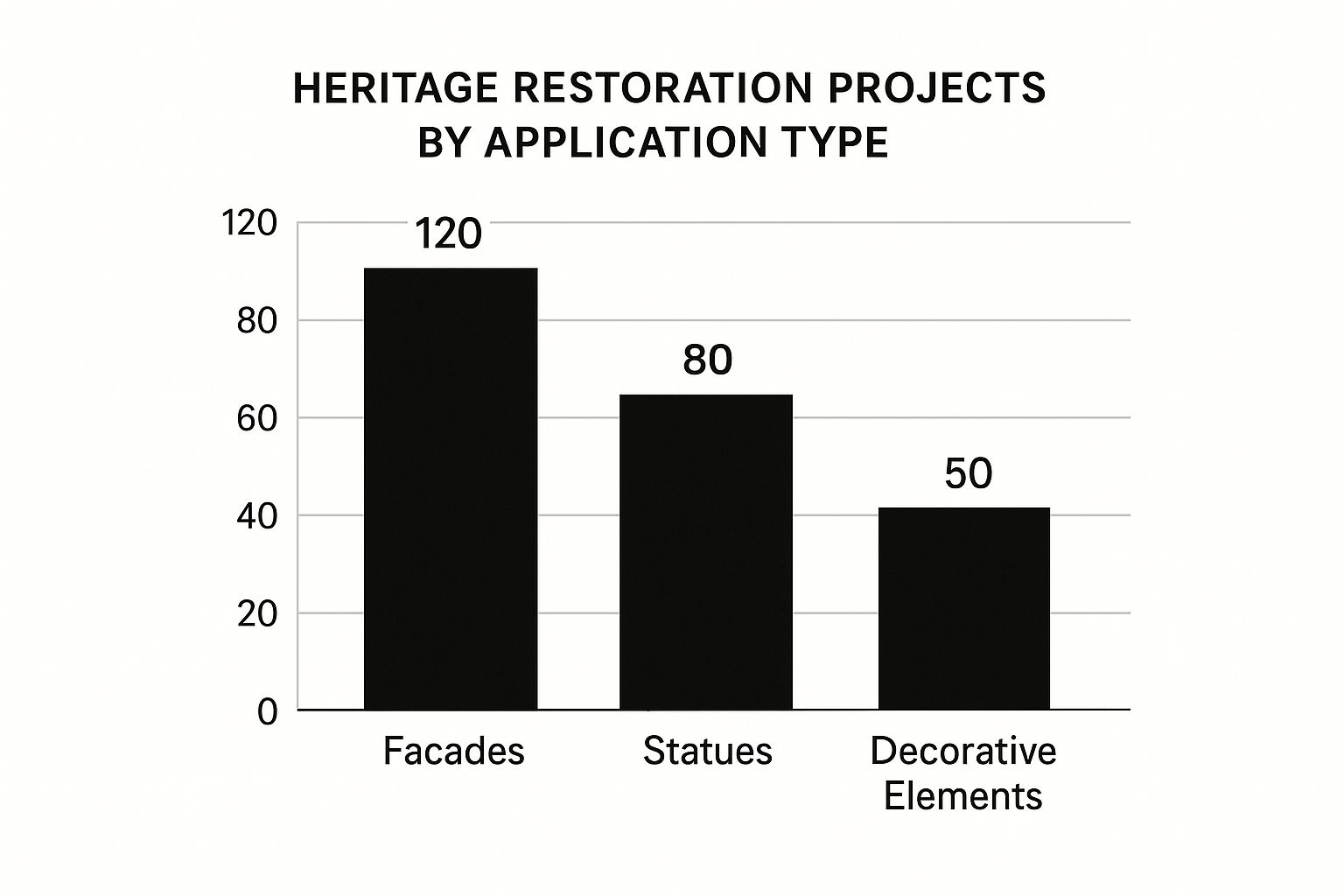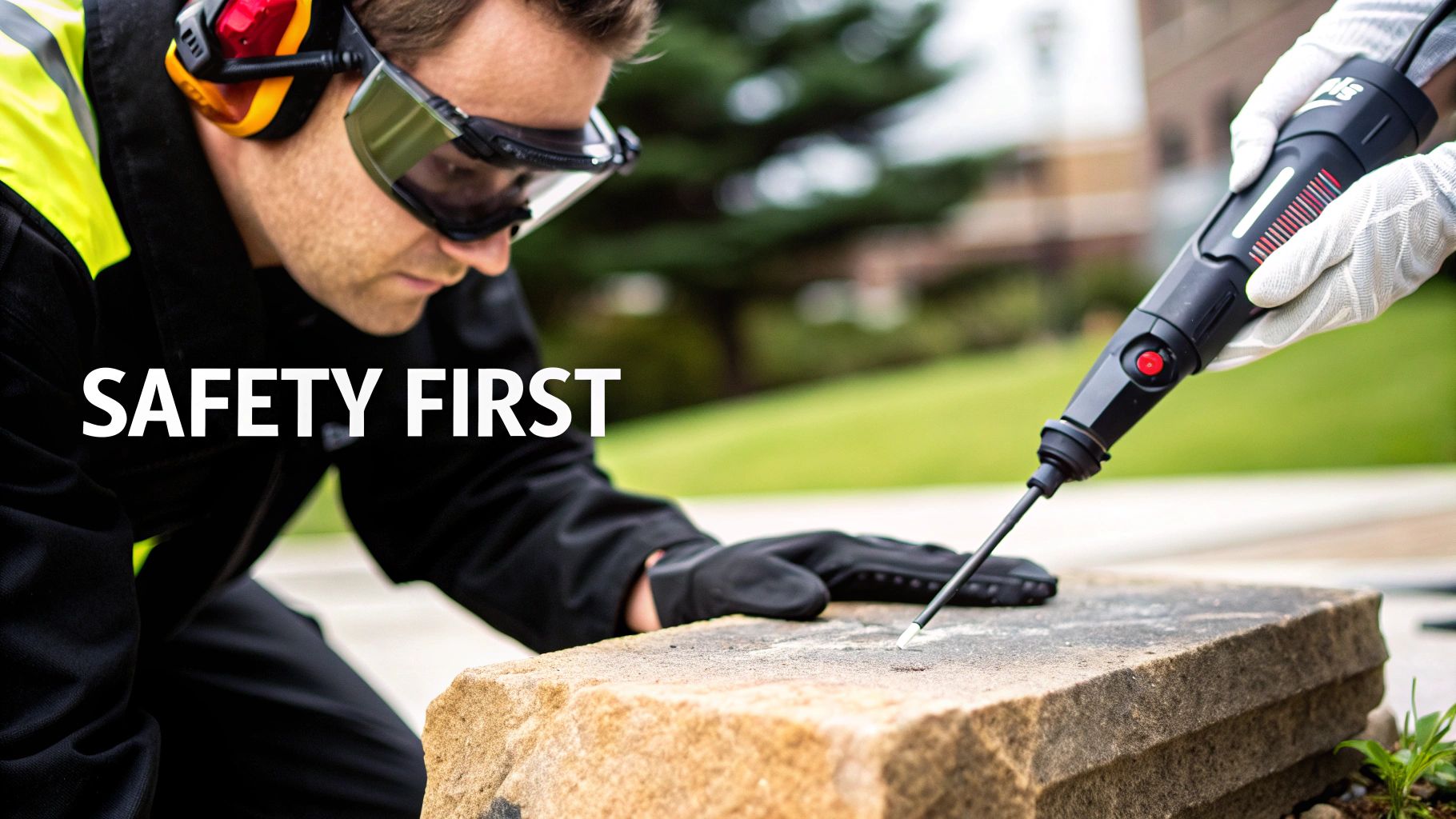Laser Cleaning Stone: Expert Restoration Techniques
- Laserverse
- May 16
- 10 min read
The Science Behind Laser Cleaning Stone
Laser cleaning stone relies on the principle of selective photonic ablation. This means the laser light targets the soiling layer—like dirt, pollutants, or biogrowth—without affecting the stone underneath. It’s a precise, molecular-level cleaning process, ideal for preserving the intricate details of historical stonework.
How Does Selective Photonic Ablation Work?
The laser emits a controlled beam of light at a specific wavelength. Different materials absorb different wavelengths. Conservationists carefully select the wavelength to target the contaminant but not the stone. For instance, removing black crust from granite might use a different wavelength than removing graffiti from sandstone. This focused approach minimizes damage, especially vital for California's irreplaceable mission architecture and historic monuments.
The laser's pulse duration is also crucial. Short pulses deliver intense energy to the soiling layer, vaporizing it rapidly. This thermal confinement limits heat spread to the surrounding stone, reducing the risk of cracking or discoloration. Think of it like quickly removing a stain without scorching the underlying fabric.
Laser Cleaning Stone's Evolution in California
Laser cleaning in stone conservation has a rich history. Globally, it’s been explored for nearly 50 years. However, its dedicated research and application within California have been relatively limited compared to Europe, where large-scale projects began in the 1990s. A 1997 National Park Service review highlighted the need for more collaborative U.S. research centers, including in California, to advance laser cleaning techniques for preserving stone buildings and monuments. Discover more insights about laser cleaning in California's history.
Fortunately, that’s changing. California conservationists are increasingly embracing laser cleaning, recognizing its potential for addressing the state's unique environmental challenges, from wildfire soot to coastal salt exposure. Ongoing advancements in laser technology, making the process even more precise and effective, also contribute to its growing adoption. The future of stone preservation in California seems closely linked to the continued development and use of laser cleaning.
Why Conservationists Are Switching to Laser Cleaning Stone

Traditional cleaning methods often struggle to effectively preserve California's architectural heritage. Harsh chemicals can etch delicate stonework. Abrasive techniques, like sandblasting, can cause irreversible damage to historic surfaces. Laser cleaning offers a more precise solution, exceeding the capabilities of conventional methods. This technology allows conservationists to target specific contaminants—from black crust and graffiti to ingrained pollution—without affecting the underlying stone.
This precision is essential for protecting the fine details of historical stonework. Imagine cleaning grime from a complex carving. Traditional methods risk harming the intricate design. Laser cleaning, using finely tuned light beams, vaporizes the grime without impacting the artistry beneath. This reveals previously hidden details, obscured by years of soiling, offering new insights into California's history.
Laser cleaning also aligns with California's environmental regulations. Unlike chemical cleaning, it doesn't create harmful runoff or require hazardous waste disposal. This eco-friendly approach reflects the increasing focus on sustainability within the conservation community. The adoption of laser cleaning in California is growing. By the early 2020s, it represented approximately 15-20% of stone conservation projects in urban centers like Los Angeles and San Francisco. This growth is partly due to decreasing system costs (down nearly 30% in the last decade) and greater governmental support for laser-based restoration. More detailed statistics can be found here.
The ROI of Laser Cleaning
The initial investment in laser cleaning equipment might be higher than traditional methods. However, the long-term advantages justify the expense. Laser cleaning provides a greater degree of preservation, reducing the need for future interventions. This leads to significant cost savings over time, particularly for historically important buildings needing regular maintenance. This shift is encouraging major institutions across California to invest in laser technology. You can explore more related topics in Our blog categories.
Unveiling Hidden Artistry
The precision of laser cleaning has uncovered remarkable details, revealing previously unseen artistic elements. Imagine discovering faint paint traces on a mission facade, hidden for centuries. Laser cleaning makes these discoveries possible, offering a glimpse into the original artistry. These findings are invaluable for understanding California's cultural heritage. Laser cleaning is more than a cleaning method; it's a tool for historical research and rediscovery, further solidifying its importance within the California conservation community.
The following table provides a comparison between laser cleaning and other common methods for cleaning stone, highlighting their strengths and weaknesses.
To help conservation professionals make informed decisions about the best approach for their projects, we've compiled the following comparison:
Laser Cleaning vs. Traditional Stone Cleaning Methods
Cleaning Method | Precision Level | Environmental Impact | Risk to Stone Substrate | Cost Efficiency | Accessibility |
|---|---|---|---|---|---|
Laser Cleaning | High | Low | Low | High (long-term) | Increasing |
Chemical Cleaning | Low | High | Medium | Medium (short-term) | High |
Mechanical Cleaning (e.g., sandblasting) | Low | Medium | High | Low (long-term) | High |
This table clearly illustrates the advantages of laser cleaning, particularly concerning precision, environmental impact, and long-term cost efficiency. While accessibility is still improving, the growing adoption of this technology indicates a positive trend towards its wider availability.
Breakthroughs in Laser Stone Cleaning Technology

Today's laser cleaning systems offer significant improvements over their predecessors. These advancements resolve several limitations that previously prevented widespread use, changing how conservationists approach delicate stone restoration. This is particularly important in California, a state rich in architectural heritage, from Spanish missions to modern monuments.
Overcoming the Yellowing Effect
One major challenge was the "yellowing effect." Early laser cleaning sometimes left a yellowish discoloration on lighter stones, especially marble and limestone—materials commonly used in California's historic buildings. This discoloration made conservationists understandably reluctant to use the technology.
However, advancements in pulse modulation and fluence control have largely solved this issue. By precisely controlling the laser's energy output and pulse duration, technicians can now clean delicate stones without discoloration. This has been critical in gaining the trust of conservation professionals and broadening the use of laser cleaning in California.
By the 2010s, laser cleaning became a preferred method for preserving delicate stone, partly due to overcoming this yellowing effect. Optimizing laser settings, particularly using Q-switching at 1064 nm, allows safe and reversible cleaning on the marble and limestone frequently found in California's architectural heritage. More detailed statistics can be found here.
Beam Profile Optimization: A Precise Touch
Another key development is beam profile optimization. Early lasers often produced uneven beam profiles, leading to inconsistent cleaning. Modern laser systems, however, generate highly uniform beam profiles, allowing for extremely precise cleaning.
This precision is essential for preserving microscopic surface details, often difficult to achieve with traditional methods like sandblasting. This makes laser cleaning ideal for the intricate carvings and delicate ornamentation found on many historic buildings in California.
Wavelength Selection: The Right Tool for the Job
Different stones respond best to different light wavelengths. Conservationists now carefully choose specific wavelengths for different stone types to optimize the cleaning process. For instance, a wavelength effective for removing black crust from granite may not be suitable for cleaning sandstone.
This understanding of wavelength-material interaction allows for a more customized approach to each project. In California, this is especially important due to the variety of stone types used in historical construction. Choosing the right wavelength ensures efficient cleaning while minimizing potential damage. This expertise in wavelength selection is increasingly vital as conservationists address a wider array of stone cleaning projects across California.
Matching Laser Parameters to Your Stone Type

The infographic above shows the breakdown of heritage restoration projects by application type. Facade restoration takes the lead, followed by statues and decorative elements. This underscores the considerable need for laser cleaning in maintaining historical buildings in California. However, different stones react differently to laser cleaning, and incorrect settings can cause damage. This section explains how to adjust laser parameters for various stone types commonly found in California's historic structures, from the sandstone of Spanish missions to the granite in civic monuments.
Understanding Key Laser Parameters
Wavelength, fluence, and pulse duration are crucial factors in the effectiveness and safety of laser cleaning on stone. Wavelength refers to the type of light the laser emits, which impacts how various materials absorb its energy. Fluence represents the laser beam's energy density—how much energy reaches a specific area. Pulse duration is the length of each laser pulse, influencing how the heat interacts with the stone. For more information on related topics, visit our sitemap for more blog posts.
Stone-Specific Considerations
Each type of stone has unique properties, including mineral composition and porosity, affecting its response to laser cleaning. Porous sandstone, for instance, requires different settings than dense granite. Past treatments, like coatings or sealants, can also influence the optimal cleaning parameters.
Field Assessment and Testing
A thorough field assessment is vital before beginning any laser cleaning project. Conservation professionals must identify the stone type, evaluate its condition, and determine the type and extent of soiling. This involves careful visual inspection and often includes testing small, hidden areas with various laser parameters to pinpoint the ideal settings.
Adapting to California's Unique Challenges
California's diverse climate creates unique preservation challenges. Coastal salt exposure can accelerate stone decay, while wildfire soot demands specialized cleaning methods. Professionals must modify laser parameters to address these regional concerns. For example, higher fluence might be needed for thick soot layers without harming the stone beneath, while lower fluence might be necessary for salt-damaged surfaces.
To help guide conservation efforts, the following table offers recommended laser settings for different stone types commonly found in California's historic structures:
Laser Cleaning Parameters for Different Stone Types
Stone Type | Recommended Wavelength | Optimal Fluence Range | Pulse Duration | Special Considerations | Typical Applications |
|---|---|---|---|---|---|
Sandstone | 1064 nm | 0.5-1.5 J/cm² | Nanoseconds | Test for potential discoloration | Mission facades, historical carvings |
Granite | 532 nm | 1.0-2.0 J/cm² | Picoseconds | Monitor for surface roughening | Civic monuments, building facades |
Limestone | 355 nm | 0.3-0.8 J/cm² | Nanoseconds | Evaluate porosity before cleaning | Architectural details, sculptures |
This table provides general guidelines. Optimal parameters will depend on the specific conditions of each project. Careful testing and evaluation are always crucial.
Properly matching laser parameters to the stone type is essential for safe and effective laser cleaning. By considering the stone’s properties, assessing site conditions, and performing thorough testing, conservation professionals can preserve California's architectural heritage for future generations.
California's Landmark Laser Cleaning Stone Projects

From the weathered sandstone of Spanish missions to the granite monuments in our bustling city centers, California's architecture displays a rich history. Preserving these stone structures presents unique challenges. Laser cleaning has emerged as a valuable tool for conservationists. This section explores some of California's most notable laser cleaning projects, highlighting the technique's versatility and impact.
Mission San Luis Rey: Combating Coastal Degradation
Located near the coast, Mission San Luis Rey suffered significant deterioration from salt spray and environmental pollutants. Traditional cleaning methods risked damaging the porous sandstone. Laser cleaning offered a gentle yet effective alternative. By carefully controlling the laser's parameters, conservationists removed grime without harming the stone. This revealed the original warm hues of the sandstone, hidden for decades. The success at San Luis Rey demonstrated laser cleaning’s potential for other coastal missions.
San Francisco City Hall: Addressing Urban Pollution
The granite facade of San Francisco's City Hall, exposed to decades of urban pollution, presented a different set of challenges. The dense granite required different laser settings compared to the sandstone of Mission San Luis Rey. Higher power levels were necessary to remove the ingrained grime, demanding careful control to prevent surface damage. The project highlighted the adaptability of laser cleaning across various stone types. The results were impressive, restoring the building's grandeur and demonstrating the effectiveness of laser cleaning in urban environments. You might be interested in: Our store products.
Stanford University Memorial Church: Post-Earthquake Restoration
After earthquake damage, the sandstone of Stanford University's Memorial Church required delicate restoration. Laser cleaning removed dust and debris from fractured stonework, preparing it for repair. The laser's precision allowed conservators to work around damaged areas, minimizing further risk. This innovative use of laser cleaning solidified its role not just in cleaning, but also in disaster recovery and structural preservation.
Unveiling Original Colors: A Statewide Initiative
Many California missions feature intricate facades with traces of original pigments hidden beneath layers of grime. Laser cleaning, with its controlled precision, allows conservationists to remove surface contaminants without disturbing these delicate pigments. This has led to remarkable discoveries, revealing vibrant colors unseen for centuries. These findings provide invaluable insights into the original aesthetics of these historical structures.
Future of Stone Preservation
These projects demonstrate the effectiveness of laser cleaning in preserving California's architectural heritage. From coastal missions to urban monuments and earthquake-damaged structures, laser cleaning offers a precise and adaptable solution. Each project provides valuable lessons for conservation professionals. The continued development of laser cleaning techniques promises a positive future for stone preservation in California and beyond. These successful California projects pave the way for wider use across historical structures and artistic stonework.
Integrating Laser Cleaning Stone Into Your California Practice
Convinced about the benefits of laser cleaning for stone? Excellent! Now, let's explore how to integrate this technology into your California practice. This section provides a practical roadmap for successful implementation, addressing key considerations for conservation professionals. Remember the preservation impacts highlighted in Pedra's release on Improvements, Pools And Preservation.
Choosing the Right Laser Cleaning Equipment
The first step is selecting the appropriate laser. California's diverse stone types, from mission sandstone to civic monument granite, require specific wavelengths and power levels. There's no one-size-fits-all solution. Consider portability for on-site work versus the power needed for larger projects.
Understanding Operational Costs
Analyze the costs associated with laser cleaning. This includes equipment purchase or rental, training, and maintenance. Compare these expenses with traditional methods. While the initial investment for laser cleaning might be higher, the long-term benefits, like reduced repeat cleanings and minimized damage, often lead to greater cost efficiency.
Staff Training and Safety Protocols
Investing in proper training is crucial. Operating a laser requires specialized knowledge for safe and effective use. Establish strict safety protocols that comply with California regulations to protect both your staff and the historic stonework.
Laser safety certification: All operators should receive the necessary certification.
Personal protective equipment (PPE): Provide essential PPE, including laser safety eyewear.
Controlled access zones: Designate specific work areas and restrict access during laser operation.
Navigating Regulatory Requirements
California has stringent environmental regulations. Laser cleaning, generally an eco-friendly process, aligns well with these requirements. However, ensure compliance with all applicable permits and regulations regarding air quality and historical preservation.
Building Collaborative Networks
Connect with leading conservation institutions and laser cleaning experts in California. Sharing knowledge and best practices can refine your approach. Explore collaborations for equipment sharing or joint projects.
Funding Opportunities
Investigating funding sources, such as grants for heritage preservation, can ease the transition to laser cleaning. California offers various grant programs for cultural heritage projects that might cover equipment acquisition or training costs.
Documentation and Workflow Development
Develop clear documentation procedures for every project. This includes pre-cleaning assessments, laser parameters used, and post-cleaning evaluations. Consistent documentation ensures repeatable results and provides valuable data for future projects, particularly for historically significant structures in California.
Setting Client Expectations
Clearly communicate the benefits and limitations of laser cleaning to your clients. Educate them about the process, expected timelines, and outcomes. Setting realistic expectations builds trust and ensures project satisfaction.
By following this roadmap, you can confidently integrate laser cleaning, enhancing your conservation capabilities and contributing to the preservation of California's architectural heritage. Ready to explore the possibilities for your next project? Learn more about Laserverse and our advanced laser cleaning systems at https://www.laserverse.ca.

